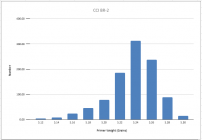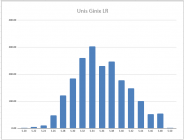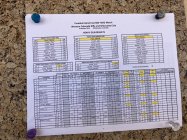Back to the original question....I use the plastic containers/lids that restaurants use for sauces in a to go order. Raid your local salad bar. I'm not worried about safety, they don't leave the shop.
I'm just starting to do this to see if it will give me better results, sorting to +/- .00025 grams because I can. Fun fact...the distribution is very gaussian. Unfortunately that means that I need to sort a lot of primers to get enough for a shoot and that's only from those weights around the mean. The heavy and light ones will go back into storage for after the apocalypse.
Would some please explain to this old man why one sorts and weighs primers?
Is the weight in the anvil? The primer mix? The cup? Does it matter? Can someone show me "on the target" that it matters? Inquiring minds want to know. We as shooters tend to complicate things as much as we can
Is the same group of primers weighed after firing to determine any difference in weight was in the primer material and not the primer body itself? Not sure how to clearly word it but weighing only prior to firing is incomplete and less valuable data it would seem.
Never have weight sorted primers. I have sorted Federal Match by color or the way the looked in the past. The compound being more red or green. I shoot Highpower Long Range. Does it help? Maybe. A very well known Highpower shooter once told me of sorting brass and bullets was to look for the outliers, what may put you in the 9 ring or worse. Overall it didn’t really matter but once sorted, why mix them back up. I’ve found off weight bullets in well known brands. It happens.
I started weighing primers many years ago and do it now as a matter of routine now instead of watching TV. However, this weekend my partner had a shooting train wreck at a match and we ultimately traced the problems down to 3 BR2 primers had no priming compound in them so they couldn't fire and others had very little priming compounds resulting in handfires. Opened my eyes up to the value of weighing my primers for important matches!!
So each primer must be weighed individually? Or 10 can be weighed at a time and will weigh xx.x grams and if any deviation then those 10 weighed individually?
So each primer must be weighed individually?
Yes.
Or 10 can be weighed at a time and will weigh xx.x grams and if any deviation then those 10 weighed individually?
Nope.
Wow. I just got 2k primers delivered. Even as blank (insert personality/condition/diagnosis of choice) as I am I'm not sure I could individually weigh 2k of them.
So each primer must be weighed individually? Or 10 can be weighed at a time and will weigh xx.x grams and if any deviation then those 10 weighed individually?
No to weighing 10 at a time. You could weigh 10 at 0.350 grams each giving a total weight of 3.50 grams.
Then weigh 10 with 8 at 0.350 ,1 at 0.300 grams and 1 at 0.400 grams and still have a total weight of 3.50 grams. Therefore not detecting the 2 outliers.
So each primer must be weighed individually? Or 10 can be weighed at a time and will weigh xx.x grams and if any deviation then those 10 weighed individually?
Yes to individually. It can go pretty quickly, if you set up what you need ahead of time. I place the primers to be weighed in front of the scale and use my RCBS primer flip tray to get them in a single layer, one sleeve of 100 at a time. I then put 4-6 cups on each side of the scale. Using tweezers, I put a primer on the scale and read the weight. Then I put a second primer on the scale, taking the first off and into a labeled cup of that weight, then read the weight of the second primer. I put a third primer on the scale and put the second into its weight cup, and so on. This minimizes movements to the scale. Forgot the weight? put it back on the scale like you had just grabbed it from the unweighed pile. I can do 1000 in under an hour this way. I also re-zero the scale every 100 primers.
No to weighing 10 at a time. You could weigh 10 at 0.350 grams each giving a total weight of 3.50 grams.
Then weigh 10 with 8 at 0.350 ,1 at 0.300 grams and 1 at 0.400 grams and still have a total weight of 3.50 grams. Therefore not detecting the 2 outliers.
That makes sense. I hadn't gotten that far in thinking about it all. Just trying to think if there's any way to make it any easier. Is there a standard weight for a primer? You used 0.350. How much variation, if any, is considered acceptable? Two of those would be 0.700. So could you weigh them two at a time? Then one being off is apparent and can't blend in.
Is there a standard weight for a primer? You used 0.350. How much variation, if any, is considered acceptable?
Depends on the primer. Large Rifle weigh more than Small Rifle. Mil Spec are usually heavier than "standard" because of a thicker cup, BR primers
may have a narrower distribution than "standard" primers. Here's charts for 1001 CCI and 1938 Unis Ginix large rifle primers. Far fewer "buckets" with the CCI compared to the UG. I separate by 0.02 grain increments (the limit of my scale). With CCI 450s I also had 10 separate containers, but didn't graph their distribution.
-

CCI.png
9.8 KB
· Views: 38
-

UG.png
9.1 KB
· Views: 38
I store weight sorted primers in their original containers with the weights marked on them.
Borrowing 64R's CCI diagram, I start by weighing one and zeroing the scale with it. I'll weigh about 10 more trying to find the center point of the weight distribution. After selecting one that looks like it'd be in the 5.22 - 5.24 range, I do a final zero on the scale and set that primer aside to use as a drift checking standard. The horizontal axis of 64R's diagram will now be labeled -.04, -.02, 0, +.02, +.04. Only 1 digit to react to makes the process go faster and is less prone to error. There isn't any point in doing this on a strain gage scale and a triple beam would make it impractically tedious.
It takes me 3-4 hours to get through 1000. After sorting, the primers are loaded back into trays starting at one end of the distribution moving to the other. The trays are marked with the weight range in them. As pointed out above, 100 primers covers a larger range at the ends of the distribution so I mark the first and last trays. I call them the torn ends. 4 hours is a bit tedious, but it's under 30 minutes per 100.
I'll only put this effort into ELR ammo. Even then, any benefits would be really tough to see in ammo that had SDs much above maybe 6 fps. I'm not a bench rest shooter, but my take on it for 100 yards is if a 3/8" group doesn't completely ruin your day, I doubt you'll see it. For those of us that don't shoot bench rest at that level, the chrono is a better way to look for primer sorting effects.
Let's say unsorted primers contribute 25 fps to the velocity ES of 60 fps. That'd be middle of the road commercial match ammo. Next, let's assume sorting completely eliminates the 25 fps spread. The new spread will not be 60 - 25 = 35. Because the rest of the contributors to the 60 fps ES are random and doing their own thing, it'll likely be closer to:
(60^2 - 25^2)^1/2 = (3600 - 625)^1/2 = 54.5 fps ES
That 5.5 fps drop probably won't be seen unless you're really looking for it and using very large groups to do it. It's probably not yet time to be sorting primers. I load a lot of 223 ammo with 10 shot ESs around 25 fps so I don't buy 26 fps from primer sorting. My guess is it's 1/4 to 1/3 that.
My 223 long range practice load typically has a 10 shot SD of 8-9 and ES's between 25 and 30. LC brass bought new, no neck turning, no primer sorting. This setup is for loading relatively quickly. At 1000 yards, 25 fps gives 6" of vertical with the 75 ELDm. It won't but let's say this load will hold 10" of vertical and that we eliminate the velocity spread. Same error budget / RMS math as before.
(10^2 - 6^2)^1/2 = (100 - 36)^1/2 = 8"
The 2" reduction isn't much unless you're competing at a very high level. Moving from the chrono to a target brings the real world into it. This calc is just for the equipment. You'll never actually eliminate the velocity spread and primer weight is only a small part of it at the 25 fps ES level.
So why sort primers for ELR? Because the contribution of velocity spread to vertical becomes more significant. Even here, it's probably questionable unless your 10 shot SDs are consistently mid single digit for 10 shot strings and you have ready access to a range with a lot of really nice days.
Whew. I'm exhausted and all I was doing was trying to keep up with all that. Can't imagine if I was actually doing it all. And for those of us basically day one new, ELR is extreme long range? Or something else?
It's definitely easier being a plinker than a shooter.

ELR is Extreme Long Range. Basically, a mile or more.
The post started with turning statistics into actionable strategies. I tried to provide a way to estimate the effects you're looking for and break points on where to even bother trying. The perspective also explains why some try it and find nothing and others can reliably see the benefit.
I'll use the same basic process to sort a larger lot of newer brass into smaller batches. No, there isn't a 1:1 correlation on brass weight and volume, but the relationship will be consistently closer after weight sorting. Primers are similar. The difference with brass is I'll only do it once and brass lasts ~10 firings at the pressure I load to.
Reading threads like this are one way plinkers start down the rabbit hole to shooters.
Tunes seem to mask some es, even out to extreme distances. But the primer thing can show on target and my thoughts are it's more related to ignition is why.
Tom
Shooting an SML with 209s, I decided to weigh them. Considering QC is probably, they're going to work or not, I wasn't surprised to see large variations in weight. When I got a half dozen or so that were within reason, I tried them. Powder weighed to .02. Even at 100m, tighter groups, no flyers and ES within 10 fps.

Look at the group agg’s
With folks tuning and shooting that well, ya can’t leave anything on the table.
Yay! I got one right. Well, one of these days maybe I'll transition from a plinker to a shooter, but not a long range shooter. But hey, I could try out that fancy new-fangled thing I heard about, the 200 yard range.

Ok so you just sorted a bunch of primers. I can't help but wonder what others are doing to store them?
Baby food glass jars?
Tiny Tupperware?
Back in the factory packaging?
How do you store them?
Thanks!!
I sort just enough for a week of reloading. and leave them in primer flipping trays. The weights are labeled on the trays. I will say, using federal match primers, they are so consistent there are only 2 weights that come up, 3.6 and 3.7













